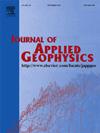Possible weaken of Rayleigh waves in weak porous media: Effects of surface drainage
IF 2.1
3区 地球科学
Q2 GEOSCIENCES, MULTIDISCIPLINARY
引用次数: 0
Abstract
In unconsolidated weak porous media, the slow P2 wave may overtake the S wave across the characteristic frequency fc as a fast slow P2 wave (FSP2). The FSP2 can destructively interfere with the first Rayleigh wave (R1), which is generated by the fast body waves (P1 and S waves) along the free surface interface. These phenomena are discovered under sealed closed pore (cp) hydraulic contact on the free surface, as described by poroelastic theory. However, under permeable open pore (op) hydraulic contact, the FSP2 wave does not affect the R1 mode. It is speculated that the interference may be dominated by the second Rayleigh wave (R2), which is only excited under cp conditions. In weak porous media, the R2 wave may destructively interfere with the first Rayleigh wave (R1) when the FSP2 appears, causing it to transition to a inverse-dispersion surface wave mode. This induces strong attenuation of the R1 wave, thereby weakening pore pressure build-up and displacement penetration. This discovery suggests that preventing fluid transport on free-surface interfaces can effectively absorb the impact of vibrations caused by Rayleigh surface waves, providing a new perspective for seismic protection of weak near-surface media.
弱多孔介质中瑞利波的可能减弱:地表排水的影响
在松散弱多孔介质中,慢P2波可能在特征频率fc上超过S波,成为快速慢P2波(FSP2)。FSP2对沿自由表面界面的快速体波(P1波和S波)产生的第一瑞利波(R1)具有破坏性干扰。这些现象是在孔弹性理论描述的自由表面密封闭孔(cp)水力接触下发现的。而在可渗透开孔(op)水力接触条件下,FSP2波对R1模态没有影响。推测干扰可能是由第二瑞利波(R2)主导的,它只在cp条件下被激发。在弱多孔介质中,当FSP2出现时,R2波可能与第一瑞利波(R1)发生破坏性干涉,使其转变为逆色散表面波模式。这引起R1波的强烈衰减,从而减弱孔隙压力积聚和驱替渗透。这一发现表明,阻止流体在自由表面界面上的输运可以有效地吸收瑞利面波引起的振动影响,为弱近地表介质的抗震防护提供了新的视角。
本文章由计算机程序翻译,如有差异,请以英文原文为准。
求助全文
约1分钟内获得全文
求助全文
来源期刊

Journal of Applied Geophysics
地学-地球科学综合
CiteScore
3.60
自引率
10.00%
发文量
274
审稿时长
4 months
期刊介绍:
The Journal of Applied Geophysics with its key objective of responding to pertinent and timely needs, places particular emphasis on methodological developments and innovative applications of geophysical techniques for addressing environmental, engineering, and hydrological problems. Related topical research in exploration geophysics and in soil and rock physics is also covered by the Journal of Applied Geophysics.
 求助内容:
求助内容: 应助结果提醒方式:
应助结果提醒方式:


